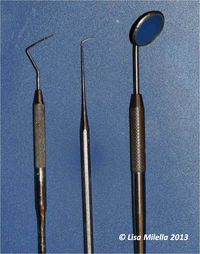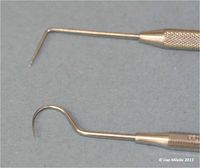Difference between revisions of "Oral Examination Instruments - Small Animal"
| (9 intermediate revisions by 2 users not shown) | |||
| Line 1: | Line 1: | ||
| − | + | ==Instruments Used to Examine the Mouth== | |
| − | + | [[File:Oral examination instruments.jpg|right|200px|thumb|Instruments used for oral examination – periodontal probe, explorer probe, dental mirror<small>''© Lisa Milella 2013''</small>]] | |
| − | + | [[File:Explorer probes.jpg|right|200px|thumb|Different examples of explorer probes<small>''© Lisa Milella 2013''</small>]] | |
| − | + | ===[[Periodontal Probe]]=== | |
| − | + | ||
| − | + | ||
| − | + | ===Dental Explorer=== | |
| − | :[[Dental | + | |
| − | + | The dental explorer or probe, a sharp-ended instrument. | |
| − | + | ||
| − | + | It is used to check for hard tissue defects for example: | |
| + | *Determine the presence of caries | ||
| + | *Explore other enamel and dentin defects, such as fractured teeth, odontoclastic resorptive lesions | ||
| + | |||
| + | The explorer is also useful for tactile examination of the subgingival tooth surfaces. Subgingival calculus and odontoclastic resorptive lesions may be identified in this way. | ||
| + | Dental explorers are available in various shapes, usually straight or curved. The Shepherds hook pattern is frequently used in veterinary dentistry, but a probe with a 90 degree bend is often easier to use, and more ideal. | ||
| + | |||
| + | ===Dental Mirror=== | ||
| + | [[File:Dental_mirror.jpg|right|200px|thumb|Dental mirror<small>''© Lisa Milella 2013''</small>]] | ||
| + | A dental mirror not often used in veterinary dentistry but is a useful tool as it allows you to visualise the palatal/lingual surfaces of the teeth easily. Orientation may cause confusion and the use of a dental mirror takes some practice. The mirror can be wiped across the buccal mucous membranes before use to prevent condensation occurring. | ||
| + | |||
| + | Dental mirrors are available in several sizes. A small (paediatric size) mirror for cats and small dogs and a larger one for medium to large dogs should be available. | ||
| − | |||
| − | |||
[[Category:Oral Examination]] | [[Category:Oral Examination]] | ||
[[Category:Dental Instruments]] | [[Category:Dental Instruments]] | ||
| − | [[Category: | + | [[Category:To Do - Dentistry Images]] |
| − | |||
Revision as of 17:17, 29 August 2013
Instruments Used to Examine the Mouth
Periodontal Probe
Dental Explorer
The dental explorer or probe, a sharp-ended instrument.
It is used to check for hard tissue defects for example:
- Determine the presence of caries
- Explore other enamel and dentin defects, such as fractured teeth, odontoclastic resorptive lesions
The explorer is also useful for tactile examination of the subgingival tooth surfaces. Subgingival calculus and odontoclastic resorptive lesions may be identified in this way. Dental explorers are available in various shapes, usually straight or curved. The Shepherds hook pattern is frequently used in veterinary dentistry, but a probe with a 90 degree bend is often easier to use, and more ideal.
Dental Mirror
A dental mirror not often used in veterinary dentistry but is a useful tool as it allows you to visualise the palatal/lingual surfaces of the teeth easily. Orientation may cause confusion and the use of a dental mirror takes some practice. The mirror can be wiped across the buccal mucous membranes before use to prevent condensation occurring.
Dental mirrors are available in several sizes. A small (paediatric size) mirror for cats and small dogs and a larger one for medium to large dogs should be available.


